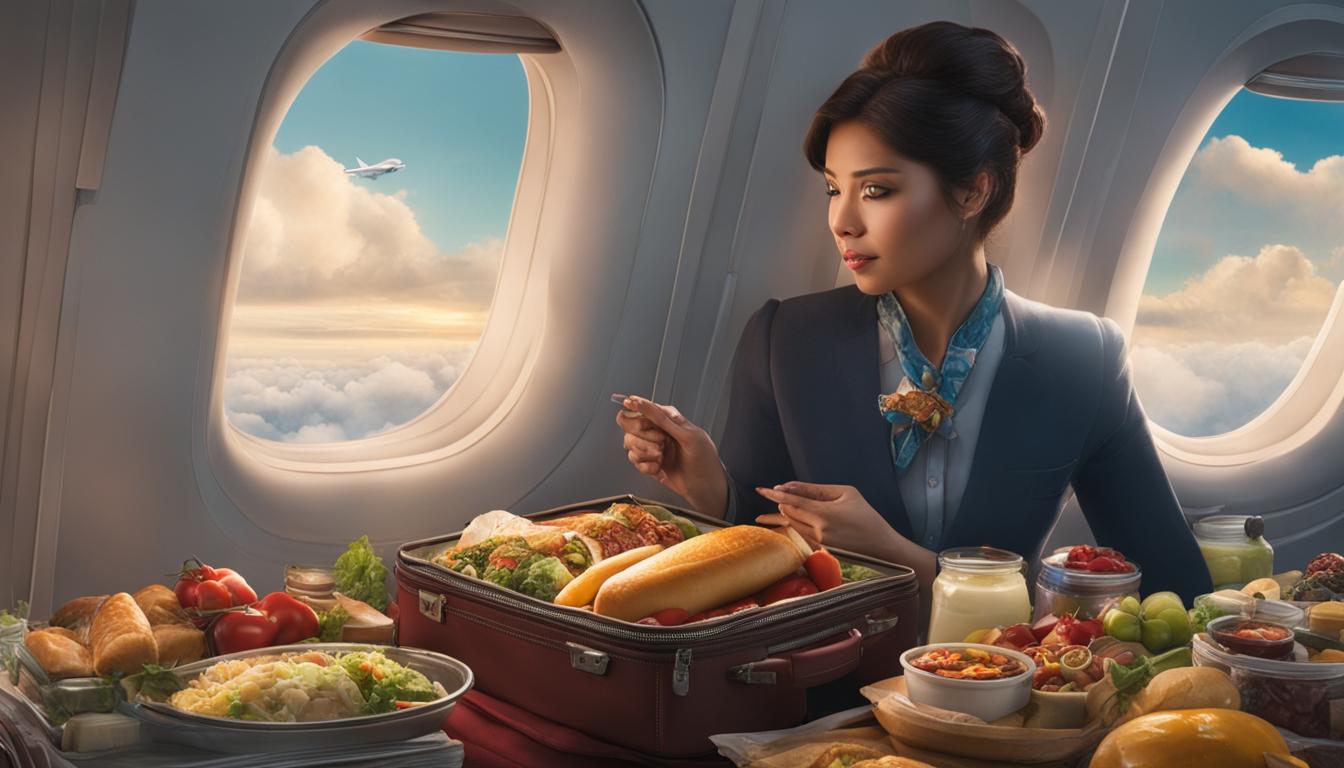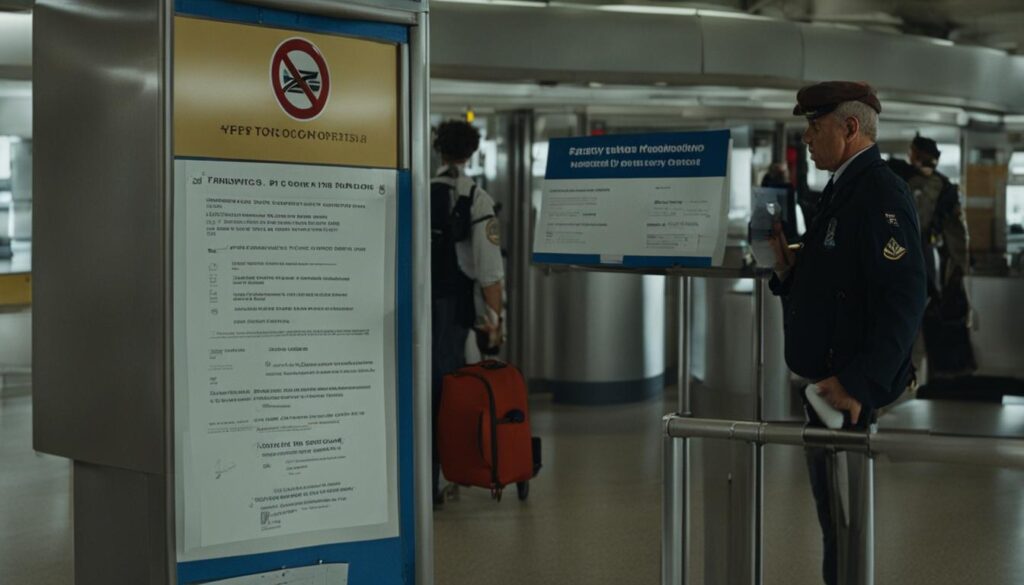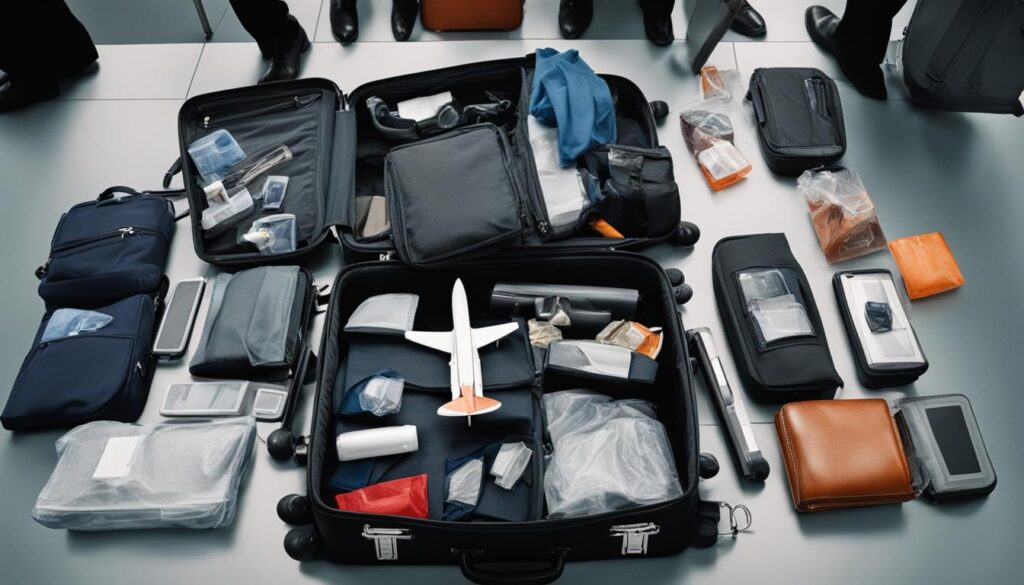Are you wondering if you can bring food on a plane? Well, you’ve come to the right place! Traveling can be hungry work, and it’s always best to be prepared when it comes to snacks and meals during your flight. But before you start packing your favorite treats, it’s important to know the rules and guidelines set by the Transportation Security Administration (TSA) regarding food items on planes.
When it comes to liquids, the TSA follows the 3-1-1 rule, which means that all liquid food items must be in containers of 3.4 ounces or less, and all containers must fit in a single quart-sized bag. However, many solid food items are allowed in both carry-on and checked bags. So, what can you bring? Let’s find out!
Key Takeaways:
- There are certain TSA rules and guidelines for bringing food on a plane.
- Liquids must follow the 3-1-1 rule, while many solid food items are generally allowed.
- Approved foods include hard cheese, frozen seafood, dried spices, packaged snacks, bread, coffee beans, and more.
- Some liquid food items, like hummus or creamy cheese, need to comply with the 3-1-1 rule.
- It’s important to consider food safety and any special rules or restrictions when packing food for air travel.
TSA Food Rules for 2022 – Updated
When it comes to bringing food on a plane, it’s essential to be aware of the TSA’s rules and regulations. In 2022, the TSA has updated its guidelines to ensure the safety and security of passengers. One of the key rules to keep in mind is the 3-1-1 rule for liquid food items in your carry-on bag. This means that all liquid foods must be in containers of 3.4 ounces (100 milliliters) or less. Furthermore, all containers must fit in a single quart-sized bag.
While liquid food items must adhere to the 3-1-1 rule, there is more flexibility for solid food items. In general, solid foods are allowed in both carry-on and checked bags. This includes a wide variety of items such as bread, cooked meat, hard-boiled eggs, candy, cereal, cookies, crackers, chips, dried fruit, nuts, sandwiches, pizza, pasta, salads, and even fresh fruits and vegetables in dried form.
It’s important to note that certain liquid food items fall under the 3-1-1 rule and need to be packed accordingly. Some examples include hummus, creamy cheese, nut butters, honey, ice cream, jams and jellies, oils and vinegars, salad dressings, salsas and sauces, soups, and yogurt. Pack these items in containers of 3.4 ounces or less and make sure they fit in your quart-sized bag.
When traveling with food, it’s always a good idea to double-check the TSA’s current regulations and any specific rules for your destination country. By understanding the updated TSA food rules for 2022, you can ensure a smooth and hassle-free experience when bringing food on a plane.
Table: TSA Food Rules for 2022
| Liquid Food Items | Solid Food Items |
|---|---|
| Hummus | Bread |
| Creamy Cheese | Cooked Meat |
| Nut Butters | Hard-Boiled Eggs |
| Honey | Candy |
| Ice Cream | Cereal |
| Jams and Jellies | Cookies |
| Oils and Vinegars | Crackers |
| Salad Dressings | Chips |
| Salsas and Sauces | Dried Fruit |
| Soups | Nuts |
| Yogurt | Sandwiches |
| Pizza | |
| Pasta | |
| Salads | |
| Fresh Fruits and Vegetables (in dried form) |
Tips for Bringing Food on a Plane
When it comes to bringing food on a plane, it’s important to consider food safety and be aware of any special rules or restrictions. Here are some helpful tips to keep in mind:
1. Pack snacks for travel
Bringing your own snacks can save you money and ensure you have something you enjoy during the flight. Opt for non-liquid items like granola bars, trail mix, or dried fruits and nuts. Remember to label any homemade or unlabeled snacks to avoid confusion.
2. Ensure food safety during air travel
Food safety is crucial when traveling. Use vacuum-sealed packaging for non-liquid items to keep them fresh and prevent contamination. If you’re bringing perishable items like sandwiches or cooked meat, pack them in an insulated cooler bag with ice packs to maintain proper temperatures.
3. Know the rules for baby food and formula
If you’re traveling with an infant, familiarize yourself with the special rules for baby food and formula. These items are exempt from the 3.4-ounce rule, but may require additional screening. It’s a good idea to let the security officers know you have baby food or formula in your bag to facilitate the process.
4. Be aware of prohibited food items on flights
Certain food items are prohibited on flights for safety reasons. These include high-proof alcohol, flammable substances, and items with strong odors that may disturb other passengers. Make sure to check the latest regulations from the TSA and U.S. Customs and Border Protection to ensure you’re not carrying any prohibited items.
By following these tips, you can ensure a smooth and enjoyable journey while bringing your favorite snacks and food items on the plane.




